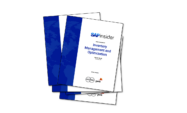SAP Inventory Management
Filter By
Browse By
- SAP Analytics and AI
- SAP Application Development and Integration
- All SAP Application Development and Integration
- SAP ABAP
- SAP ABAP Development Tools
- SAP ABAP Test Cockpit
- SAP API Management
- SAP BAPI
- SAP Basis
- SAP BRF
- SAP Business Application Studio
- SAP CMS
- SAP Design Studio
- SAP Development Tools
- SAP DevOps
- SAP EAI
- SAP EDI
- SAP Extension Suite
- SAP Fiori
- SAP Fiori Elements
- SAP Integration Suite
- SAP Low Code Application Development
- SAP Low Code Automation
- SAP Netweaver
- SAP Release Management
- SAP UI5
- SAP Web Application Server
- SAP Web IDE
- SAP Business Process Management
- SAP Center of Excellence
- SAP CIO
- SAP Customer Experience
- SAP Data and Data Management
- All SAP Data and Data Management
- SAP BW
- SAP BW/4HANA
- SAP Crystal Reporting
- SAP Data Archiving
- SAP Data Center
- SAP Data Governance
- SAP Data Integration
- SAP Data Migration
- SAP Data Quality
- SAP Data Services
- SAP Data Strategy
- SAP Data Visualization
- SAP Data Warehouse Cloud
- SAP DMS
- SAP Document Control
- SAP EIM
- SAP ETL
- SAP ETL Tools
- SAP HANA
- SAP HANA Administration
- SAP HANA Deployment Infrastructure
- SAP HANA Studio
- SAP Master Data
- SAP Master Data Governance
- SAP MDM
- SAP Enterprise Architect
- SAP Enterprise Asset Management
- SAP ERP
- SAP Finance
- All SAP Finance
- SAP Accounting
- SAP AR AP
- SAP Asset Accounting
- SAP Billing Systems
- SAP BPC
- SAP BRIM
- SAP Cash Management
- SAP Central Finance
- SAP Controlling
- SAP COPA
- SAP Cost Center Accounting
- SAP e-invoicing
- SAP FICO
- SAP Finance Automation
- SAP Financial Closing Cockpit
- SAP Financial Consolidation
- SAP Financial Planning
- SAP FX Risk
- SAP General Ledger
- SAP Global Tax Management
- SAP Hyperion
- SAP Order to Cash
- SAP Payment Processing
- SAP Profitability Analysis
- SAP Rebate Management
- SAP S/4HANA Finance
- SAP Universal Journal
- SAP Governance Risk and Compliance
- SAP Human Capital Management
- SAP Intelligent Technologies
- SAP Platform and Technology
- All SAP Platform and Technology
- SAP Business Technology Platform
- SAP Cloud Connector
- SAP Cloud Integration Platform
- SAP Cloud Migration
- SAP Cloud Platform
- SAP Cloud Providers
- SAP Cloud Strategy
- SAP Container Platform
- SAP Digital Asset Management
- SAP Digital Integration Hub
- SAP Digital Signature
- SAP HANA Enterprise Cloud
- SAP HEC
- SAP Hyperscalers
- SAP Infrastructure
- SAP Messaging
- SAP Smart Forms
- SAP Quality and Testing
- SAP Security
- SAP Spend Management
- SAP Supply Chain Management
- All SAP Supply Chain Management
- SAP APO
- SAP Asset Management
- SAP Business Network
- SAP Digital Manufacturing Cloud
- SAP Digital Twin
- SAP EWM
- SAP IBP
- SAP Inventory Management
- SAP Label Printing
- SAP Logistics
- SAP Manufacturing
- SAP Manufacturing Automation
- SAP MES
- SAP MII
- SAP MM
- SAP MRO
- SAP MRP
- SAP Order Management
- SAP Plant Maintenance
- SAP PLM
- SAP Production Planning
- SAP S&OP
- SAP SD
- SAP SPM
- SAP Supply Chain Planning
- SAP Track and Trace
- SAP Transportation Management
- SAP System Administration
Supply Chain Management: SAP Inventory Management
Inventory is a fundamental part of your business. Without proper inventory management, the organization can suffer inefficiencies, profit decline, and sustainability impacts.
What is Inventory Management?
Inventory Management is the practice of controlling inventory flow for maximum organizational efficiency. It is suitable for businesses of any size and focuses on organizing and streamlining product storage and fulfillment. The management of stock can be done on a quantity or value basis. Inventory management in SAP is an important component of the Material Management (MM) module, it deals with stocks and goods movement.
With SAP, many companies have real-time data on inventories, which is vital for capacity management and expansion of complex supply chains. The application provides several management tools to help users create an organized warehousing space while uncovering valuable operational data. A couple of examples include the following.
Supply Chain Management: SAP Inventory Management
Inventory is a fundamental part of your business. Without proper inventory management, the organization can suffer inefficiencies, profit decline, and sustainability impacts.
What is Inventory Management?
Inventory Management is the practice of controlling inventory flow for maximum organizational efficiency. It is suitable for businesses of any size and focuses on organizing and streamlining product storage and fulfillment. The management of stock can be done on a quantity or value basis. Inventory management in SAP is an important component of the Material Management (MM) module, it deals with stocks and goods movement.
With SAP, many companies have real-time data on inventories, which is vital for capacity management and expansion of complex supply chains. The application provides several management tools to help users create an organized warehousing space while uncovering valuable operational data. A couple of examples include the following.
Physical locations or organizational levels:
- Plant: A high-level physical location to which the materials are assigned.
- Storage Location: A specific area within the plant where the material is stored.
Four primary movement of goods are:
- Goods Receipt: Inventory can be approved for immediate use or be checked in.
- Goods Issue: A company may choose to process inventories for production or to sell to customers.
- Return Delivery: When materials are being returned from a customer or vendor.
- Internal Movements: When inventory is transferred internally from one location to another.
Most importantly, proper inventory management allows you to move goods with as little wasted time and money as possible. It can help you to optimize demand fulfillment for e-commerce, which is quickly becoming the norm in business to business today.
Benefits of SAP inventory management are:
- Accuracy and timeliness
- Realistic production schedule
- Quality checking
- Inventory analysis
- Proper reporting.
Technical resource partners for consideration might be –Movilitas, Opsveda, SAP.
Further insights for SAPinsiders around SAP Inventory Management
- Real Time Inventory and Order Visibility: Key for Successful Supply Chain Management. Probodh Chiplunkar from Ithena Technologies, outlines how real-time inventory transparency within a technological landscape affects business operations.
- Pick and Choose: How Kingston General Hospital Manages its Inventory with SAP. Author Davin Wilfrid interviews Derrick Morey at Kingston General Hospital (KGH), about the complex network of systems and people managing all the tubes, bandages, needles, and other medical supplies distributed throughout KGH. As an early adopter of SAP ERP technology, the hospital adopted a centralized inventory management system to track supplies for better accuracy.
- Next-Generation Inventory Management. Tom Chason addresses questions about the SAP Enterprise Inventory and Service-Level Optimization and SmartOps solutions. See how an integrated approach offers a powerful way to meet all these requirements for modern supply chains.
499 results
-

Make the Move to SAP Cloud Platform ABAP Environment with Confidence
Reading time: 18 mins
A fully digital approach to operations enables not only efficiency, but also resiliency and stability during disruptive times, such as the COVID-19 crisis. Cloud-based solutions allow businesses to continue running at any time and from anywhere, and cloud-delivered software updates continuously add new features and improvements to help organizations run better. With SAP Cloud Platform…
-

 Premium
Premium
Enable a Tax-Efficient Supply Chain in SAP ERP
Reading time: 14 mins
With increased focus on international markets, companies running SAP are continually looking to better manage the flow of goods in a tax-efficient way to help grow their business and improve their bottom lines. Find out some best practices and financial considerations when distributing goods in international markets. Key Concept To reduce costs when distributing goods…...…
-

 Premium
Premium
Best Practices for Implementing Sales and Operations Planning
Reading time: 14 mins
The sales and operations planning (S&OP) process can bring about substantial improvements in the way a company manages its supply chain. Learn the building blocks of the S&OP process, what it needs in terms of technology, and how this is supported in different SAP solutions. Key Concept Sales and operations planning (S&OP) is the process…...…
-
-

Achieve Excellence in Sales and Operations Planning
Reading time: 19 mins
Sales and operations planning (S&OP) functions live at the tactical level of the planning hierarchy in an environment that synchronizes demand, inventory, and supply plans and considers profit objectives. S&OP has been discussed in multiple forums over the years because of the value it delivers to the organization as whole. In this article you will…
-

Increase Service Levels and Lower Inventory with SAP DDMRP
Reading time: 4 mins
Demand-driven material requirements planning (DDMRP) is a solution to plan materials and inventories. While traditional MRP does a respectable job of planning, DDMRP improves on that functionality to work better in a volatile environment. It enables companies to get closer to customers’ requirements, promoting faster decisions at the planning and execution level. Why can’t sales,…
-

- SAP ECC 6.0
 Premium
Premium
Seamlessly Execute Vendor-Managed Inventory Using SAP APO 7.0 and SAP ECC 6.0
Reading time: 10 mins
Companies who have vendors manage the inventory in their stores for specific stock keeping units often opt to use Vendor-Managed Inventory (VMI). VMI improves customer service, reduces inventory requirements, and improves customer retention. Discover how to seamlessly execute VMI across demand planning, Supply Network Planning, and sales and distribution. Key Concept Vendor-Managed Inventory is an…...…
-

 Premium
Premium
How to Use Transfer Prices for Intercompany Inventory Transfers with Standard Functionality
Reading time: 39 mins
Learn how to design a standard SAP solution to meet the business requirement to implement transfer prices or arm’s-length prices between intercompany, parent, or subsidiary inventory transfers. The main business reason for using transfer prices is to ensure that an organization having multiple affiliate companies is not manipulating income taxes by setting up prices over…...…
-
-

- SAP Supply Chain Management
 Premium
Premium
How To Optimize Inventory With All the Variables in Play
Reading time: 4 mins
Optimize Inventory Cost reduction and managing risks are two of the top three essential priorities for supply chain managers across the board, perhaps behind only supporting top-line growth. Inventory is one area in which cost reduction and risk management are critical to better financial results. How much of your company’s working capital is tied up…...…
-

- SAP Inventory Management
 Premium
Premium
Inventory Management and Optimization Benchmark Research Report
Reading time: 2 mins
Inventory management challenges and supply chain risks are growing exponentially as businesses try to manage the complexities presented by globalization. These challenges surface in the form of unprecedented fluctuations in demand and supply, inventory policies and delivery systems diversity, and geopolitical and regulatory changes. These have only intensified during the pandemic. Unsurprisingly, in SAPinsiders’s recent…
-

 Premium
Premium
Scale Up in Retail with SAP’s SCM 4.1 Inventory Collaboration Hub
Reading time: 11 mins
Although it was first introduced with SCM 4.0, few users have leveraged SAP Inventory Collaboration Hub (SAP ICH) to take control of large inventories in numerous locations. Those in retail and other industries with such requirements will find they can manage large operations more easily. Key Concept SAP ICH is heralded as SAP’s strategic supply…...…
Featured Insiders
-

Joerg Boeke
SAP BW / HANA Solution Architect, Manging PArtner BIAnalyst Gmbh & Co. KG
-

Laz Uriza
Business & Sales Strategy Director - WW SAP on Azure Strategy Lead
Global Sales & Strategy Lead, Microsoft
-

Bob Bucy
IS Business Analyst, Supply Chain, bioMerieux
Become a Member
Unlimited access to thousands of resources for SAP-specific expertise that can only be found here.
Upcoming Events
-

Register Now: SAPinsider Technovation Summit Barcelona: AI + SAP BTP
May 14 - 15, 2024
Barcelona, Spain
View Event
Related Vendors
Your request has been successfully sent
